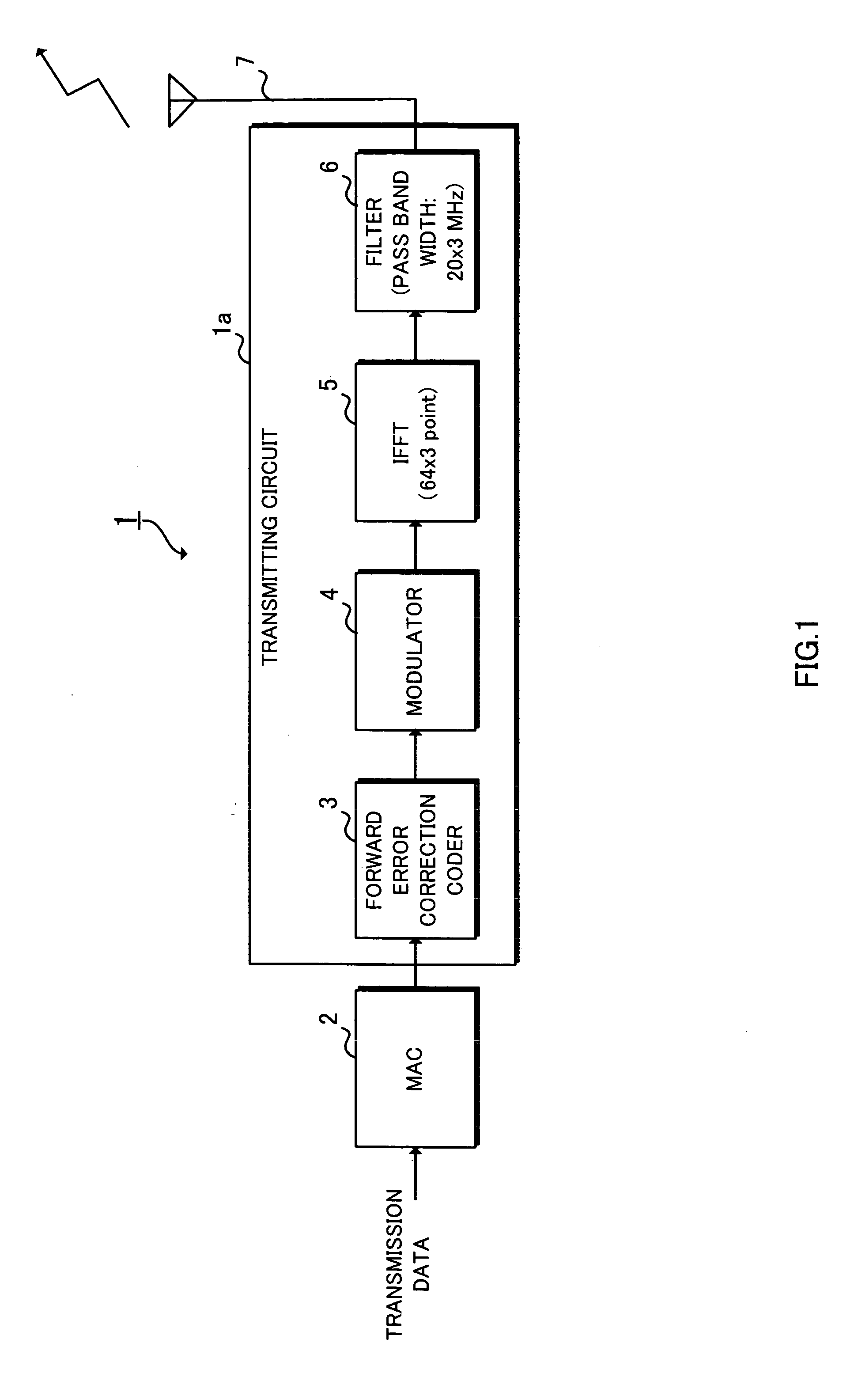Wireless LAN system
a lan system and wireless technology, applied in the field of wireless lan systems, can solve the problems of considerable deterioration in communication speed between legacy terminals and ht terminals, and achieve the effect of preventing deterioration of throughput and deterioration of throughpu
- Summary
- Abstract
- Description
- Claims
- Application Information
AI Technical Summary
Benefits of technology
Problems solved by technology
Method used
Image
Examples
first embodiment
[0099]FIG. 1 a block diagram showing a configuration of a transmitter of an HTSTA applied to a wireless LAN system according to a first embodiment and FIG. 2 is a block diagram showing a configuration of a transmitter of a legacy STA applied to a legacy wireless LAN system. In FIG. 1, in a transmitter 1 of the HTSTA, transmission data are inputted in an MAC circuit 2 and a transmitting / receiving method of a frame, which is a transmission / reception unit of data, a frame format, etc., are defined. An Forward Error Correction Coder 3 performs error correction coding for a signal inputted from the MAC circuit 2. A modulator 4 performs modulation such as BPSK (Binary PSK) or QPSK (Quadrature PSK) for a signal inputted from the Forward Error Correction Coder 3. An IFFT circuit 5 converts a signal inputted from the modulator 4 from a frequency signal into a time signal. A filter circuit 6 allows only the signals in a desired band among signals inputted from the IFFT circuit 5 to pass for o...
second embodiment
[0119] In a wireless LAN system according to a second embodiment, as in the wireless LAN system according to the first embodiment, a signal for notifying that the radio medium is occupied is transmitted and the period of time during which an HT sequence is performed is occupied logically with respect to a legacy terminal. Here, in the case where a legacy AP and an HTAP coexist in the same frequency band, as in the first embodiment, transmission of both the legacy beacon and the legacy CTS prior to the HT sequence leads to an increase in overhead. Therefore, in the second embodiment, the legacy beacon is not transmitted but the legacy CTS and the HT sequence (HT beacon, HT data) are transmitted in this order, as shown in FIG. 18. In this case also, as shown in FIG. 19, the legacy CF-poll may be used instead of the legacy CTS.
[0120] As shown in FIG. 20, the normal MAC frame that specifies the period to protect in the duration may be used. However, as explained in FIG. 14 and FIG. 15,...
third embodiment
[0122] In a wireless LAN system according to a third embodiment, coexistence of the HT terminal and the legacy terminal is realized. In other words, the HT terminal occupies a part of period of the radio medium but does not occupy another part, thereby the coexistence with the legacy terminal is realized.
[0123] In the third embodiment, the time of duration in a legacy MAC frame transmitted by the HT terminal is set to x % (x % is equal to or less than 100%) of the interval from the end of the legacy MAC frame to the next beacon. It is possible to adjust the ratio of communication time of the HT terminal to that of the legacy terminal in accordance with this ratio (the ratio of the part of the radio medium occupied by the HT terminal to the whole). FIG. 22 shows a state in which the HT terminal occupies 100% of the interval from the end of the legacy MAC frame to the next beacon. FIG. 23 shows a state in which the HT terminal occupies, for example, 70% of the interval from the end o...
PUM
 Login to View More
Login to View More Abstract
Description
Claims
Application Information
 Login to View More
Login to View More - R&D
- Intellectual Property
- Life Sciences
- Materials
- Tech Scout
- Unparalleled Data Quality
- Higher Quality Content
- 60% Fewer Hallucinations
Browse by: Latest US Patents, China's latest patents, Technical Efficacy Thesaurus, Application Domain, Technology Topic, Popular Technical Reports.
© 2025 PatSnap. All rights reserved.Legal|Privacy policy|Modern Slavery Act Transparency Statement|Sitemap|About US| Contact US: help@patsnap.com



